| Pages:
1
2
3
4
..
13 |
jdowning
Oud Junkie
    
Posts: 3485
Registered: 8-2-2006
Location: Ontario, Canada
Member Is Offline
Mood: No Mood
|
|
Benzoin as a chemical was not synthesised until 1832 so is not an historical possibility - did you mean Gum Benzoin Sazi?
So called Gum Benzoin (which does not contain Benzoin as a component) and which is obtained from the Styrax benzoin tree native to the Malaysian
peninsula would have been valued in early times as an incense. However it is not, despite its name, a gum but a balsamic resin containing aromatic
benzoic or cinnamic acids. (Myrrh is another example of this type of resin - also an incense known since early times).
Gum Benzoin is not soluble in water only in warm absolute alcohol, melts at
137 C and it does not have the flexible adhesive qualities of a true gum like Gum Arabic necessary for silk string making. So I think that Gum Benzoin
can also be discounted as an historical alternative for a true gum.
Farmer's translation of the Kanz al-Tuhaf only mentions gum not the type of gum. However, due to the widespread use and importance of Gum Arabic since
early times it may have just been referred to as 'gum' - being such a common commodity. So I shall stick with the assumption that the gum referred to
was Gum Arabic.
Above all, it has the properties required to bind the silk filaments together to make a coherent string.
Gum Arabic is soluble in water but not in alcohol. Adding a small amount of alcohol to Gum Arabic in solution apparently causes the gum to be
precipitated as a mucilage which, when allowed to dry leaves a gum with considerable adhesive properties.
Interestingly 'Tincture of Saffron' previously referred to is an extract of the dye component of the Saffron herb dissolved in alcohol (methyl or
ethyl). So is this what is meant by 'essence of saffron' in the Kanz al-Tuhaf when it is stated that"a paste of moderate consistency is then made of
gum and a little essence of saffron" - the addition of the alcohol based dye to the gum solution in water precipitating the gum into "a paste of
moderate consistency"?
Only one way to find out!
|
|
|
Sazi
Oud Junkie
    
Posts: 786
Registered: 9-17-2007
Location: Behind my oud
Member Is Offline
Mood: مبتهج ; ))
|
|
Yes, I was thinking of a tincture made with the resin, having read about it's uses and effects, however, I'm not as focussed on the needs pertaining
to the manufacture of strings as you are. It just sprang to mind, sorry to distract you, but it is a fascinating topic and brilliant work you are
doing here and I can't help but get excited about it!
|
|
|
jdowning
Oud Junkie
    
Posts: 3485
Registered: 8-2-2006
Location: Ontario, Canada
Member Is Offline
Mood: No Mood
|
|
Thanks for your interest and input Sazi - no distraction - all probing questions and ideas can be helpful in the quest to resolve the often obscure
and less than obvious historical data of centuries ago.
|
|
|
jdowning
Oud Junkie
    
Posts: 3485
Registered: 8-2-2006
Location: Ontario, Canada
Member Is Offline
Mood: No Mood
|
|
I should add (for completeness) that another natural gum of historical significance, indigenous to Turkey and Persia, is Gum Tragacanth. This - like
Gum Arabic - is a true gum but is not soluble in water - absorbing water and swelling to form a gelatinous mass. Unlike Gum Arabic, however, it does
not readily 'stick to itself' making it suitable, for example, as a binder for artist pastels but, perhaps, less so as a binder for silk strings.
Nevertheless, if trials with Gum Arabic fail, use of Gum Tragacanth may be an alternative line of investigation.
Once again, the 'Internet Archive' website is a valuable source of information free for the download. Among other technical texts on the subject "Gums
and Resins" by Ernest J. Parry may be of general interest.
|
|
|
jdowning
Oud Junkie
    
Posts: 3485
Registered: 8-2-2006
Location: Ontario, Canada
Member Is Offline
Mood: No Mood
|
|
Does alcohol precipitate a gum deposit if added to a solution of Gum Arabic in water?
Four small pieces of raw Gum Arabic were covered with 10 ml of water and left overnight to dissolve in a warm environment. After 18 hours, the gum had
completely dissolved in the water to form a clear amber coloured, semi viscous liquid. The volume of the gum dissolved in water solution was 15 ml.
(the measuring syringe has been recycled from an ink-jet printer refill kit)
The liquid gum was applied to paper strips to test for adhesion and flexibility. On drying the paper strips had curled confirming that the gum shrinks
when dry. On flexing the paper, the gum coating exhibited numerous fine cracks - so the gum is brittle.
When the gum coating was moistened with water, the cracks disappeared as the water soluble gum was reconstituted.
Paper strips glued together indicated excellent adhesive properties of the gum - the gum being stronger than the paper.
Nothing very surprising as one application of Gum Arabic is for gummed postage stamps and envelopes.
Pure Methanol (Wood Alcohol) was added to a sample of the liquid gum - little by little. Each drop of Methanol added formed a white residue on the
surface of the liquid gum. On standing, the residue dissolved to form a clear liquid with similar properties of adhesion and flexibility as the
original gum sample. After standing for several hours, a gelatinous skin had formed on the surface of the gum that dissolved to a liquid on stirring
(surface evaporation of the methanol?)
Not sure what to make of this but there is obviously no sudden precipitation of gum when alcohol is added to the gum solution - so will observe this
sample for a while longer, just to see what happens.
The authorities say that Gum Arabic is insoluble in pure alcohol so as a test a small piece of the gum has been left to soak overnight in 2 ml of
Methanol.
Methanol (and Ethanol) is miscible (soluble) in water - just to complicate matters.
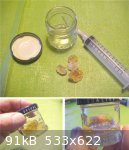

|
|
|
jdowning
Oud Junkie
    
Posts: 3485
Registered: 8-2-2006
Location: Ontario, Canada
Member Is Offline
Mood: No Mood
|
|
The small sample of Gum Arabic in water solution with Methanol added was left in an open container overnight. By this time the solution had turned to
a syrupy gel consistency - most likely due to evaporation of the alcohol and water rather than the alcohol causing precipitation of the gum?
However, as a further test to confirm this, a sample of the gum in water solution will be left overnight in an open container to see what happens.
A coating of the gelled water/methanol gum was applied to a strip of paper and allowed to dry. On flexing the paper the gum layer cracked confirming
that Methanol does not impart properties of flexibility to the gum. At this stage it is uncertain if flexibility of the gum as a binder for silk
strings is a requirement as, apparently, in the the textile industry, Gum Arabic is used to make yarn stronger and increase its tensile strength
(presumably without sacrificing flexibility of the yarn?). Good for silk strings also!
The sample of gum in Methanol has not dissolved after 24 hours confirming that Gum Arabic is insoluble in pure alcohol. However the gum is said to
dissolve in an aqueous solution of ethyl alcohol (ethanol) up to 60% concentration (in water). (Possibly also in a 60% aqueous solution of Methanol?)
Ethanol can also be used to extract 'essential oils' from plant material so while 'Tincture of Saffron' - being a pure alcohol solution - would not
result in Gum Arabic being dissolved to a 'paste' consistency a saffron 'essence' made by mixing saffron with aqueous alcohol probably would.
So the next test will be to dissolve a sample of the gum in aqueous Ethanol. Aqueous Ethanol is readily available in small quantities from the local
brewers retail outlet - I shall be using a 50ml. 'miniature' bottle of 'Smirnoff' vodka. This is a pure ethanol spirit of 40% alcohol by volume in
water so should work. Any vodka left over will not be wasted!
Gum Arabic is unique among natural gums due to its extremely high solubility in water - yielding highly viscous, gel like solutions at up to 50%
concentration.
This 'paste like' consistency of the gum, needed for silk string making - according to the tests so far - might most easily be achieved by simply
allowing a Gum Arabic solution to stand in an open container until the volatile components (water and alcohol) have evaporated to a sufficient level
to form a 'paste' convenient for rubbing into a silk string.
Of course, once the gum paste has dried out it will harden and become brittle.

|
|
|
jdowning
Oud Junkie
    
Posts: 3485
Registered: 8-2-2006
Location: Ontario, Canada
Member Is Offline
Mood: No Mood
|
|
The sample of gum in water solution - left overnight in an open container - by this morning had turned into a thick, sticky gel
(like the gum in Methanol sample did) due to evaporation of the water.
By this time, the gum in Methanol sample had completely hardened. This was readily dissolved back into a clear liquid gum by addition of 3 ml. of
water - taking about an hour to fully dissolve. So the whole process is reversible.
A test sample of Gum Arabic in 40% Ethanol (Vodka) has been prepared and left to soak overnight. It is anticipated that the gum will dissolve in the
aqueous alcohol due to the 60% water content.

|
|
|
jdowning
Oud Junkie
    
Posts: 3485
Registered: 8-2-2006
Location: Ontario, Canada
Member Is Offline
Mood: No Mood
|
|
After 24 hours of soaking in Vodka the Gum Arabic is dissolving only very slowly and is forming a slightly 'milky' liquid. So this does not look very
promising as an avenue of investigation. I suppose that the water molecules mixed with the alcohol molecules are less free to dissolve the gum as free
water in solution would have done.
Some experimentation will be necessary to determine the correct consistency of the gum/water solution to match the Kanz al-Tuhaf string makers
description of "A paste of moderate consistency" - if the gum solution is too sticky and viscous it may be impossible to "rub into the strings with a
piece of linen until it has penetrated into all the parts ..."?
However, Gum Arabic is an interesting material in solution. At concentrations in water of up to 40% it flows like water and other Newtonian fluids.
However at concentrations over 40% it takes on pseudoplastic characteristics denoted by a decrease in viscosity with increasing shearing stress. In
other words, a gum in a stiff and viscous concentration - will become more fluid when rubbed or stirred - perhaps sufficient to penetrate the
innermost fibres of a string? Just another theory to test in practice!
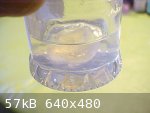
|
|
|
jdowning
Oud Junkie
    
Posts: 3485
Registered: 8-2-2006
Location: Ontario, Canada
Member Is Offline
Mood: No Mood
|
|
After 48 hours in a 40% aqueous ethanol (Vodka), the Gum Arabic sample remains largely undissolved. This confirms that Gum Arabic should first be
prepared as a solution in water after which alcohol or alcohol/water solutions may be added if required - as they are readily miscible with the gum
solution.
This result indicates that addition of an alcohol based 'essence of Saffron' will mix with the gum solution. As Saffron oil made by a distillation
process is not an option for this project, an alternative method - used to extract essential oils from dry plant material (like Saffron) - is to
employ pure alcohol as a solvent. This can be a procedure as simple as soaking the Saffron for a period of time (about a month?) in absolute alcohol
so is a practical alternative. The resulting Saffron oil/alcohol solution can then be added directly to the Gum Arabic solution prior to use as a
binder for the silk strings.
As 'pure' ethanol necessary for extraction of the oils (over 80% ethanol by volume) is not an option - requiring a Federal Excise permit to purchase -
it is planned to use pure Methanol (99.9% pure) for extracting the Saffron oils. Methanol (well known to civilisations like the Ancient Egyptians) is
a deadly poison if ingested and must be handled safely if used in quantity as it can be absorbed through the skin on contact or the fumes breathed in.
So, will it be safe to use in the process of string making? Probably - as the quantities added to each 10 ml. batch of gum solution will be small
(1ml. or less) and in the finished string both water and alcohol will have evaporated. So - as the string maker - I will be careful when handling the
stuff but there should be no concerns for the player - no more so than handling an instrument that has been finished with shellac or French polish.
A possible advantage in adding alcohol to the gum just prior to wiping the strings is that alcohols reduce the surface tension of water so should
facilitate absorption of the gum into the silk. Adding 1 ml. of Methanol to 10 ml. of gum solution should reduce the surface tension of the water
content of the gum solution by about 20%.
It would seem that the only purpose of the essence of Saffron is to dye the silk filaments - perhaps as a visual indicator to confirm 100% absorption
of the gum into the silk filaments (rather than as a cosmetic feature)? Silk filament is hygroscopic (absorbs water) so accepts dyes readily provided
the waterproof Sericin coatings have been removed from the filaments. As we have already seen, the first step in making the strings (according to the
Kanz al-Tuhaf) is to boil the silk threads in a caustic solution of wood ash a process that removes the Sericin.
So, the next step is to make a Saffron 'essence' from Methanol and then attempt to make a simply twisted 16 filament 'Hadd' string. I have a small
reel of raw silk (of unknown denier or filament count) that I shall use for the preliminary string trials. Twisting 16 of these filaments together
gave string diameter of about 0.4 mm so this thread should be good for a first attempt.
As an historical note, the distillation of herbs for perfumes and medicines dates back (at least 4000 years, based upon archeological discoveries) to
the early civilizations in Cyprus. Later, the 9th C Arabian scientist Al- Kindi wrote a 'Book of the Chemistry of Perfume and Distillations' with
over 100 recipes for fragrant oils etc. and over 100 methods for perfume making and equipment.
Persian scientist Avicenna (Ibn Sina) introduced a process for extracting oils from flowers by distillation - the procedure most commonly used today.
The ancients knew very well how to make alcohols and herbal extracts.
|
|
|
jdowning
Oud Junkie
    
Posts: 3485
Registered: 8-2-2006
Location: Ontario, Canada
Member Is Offline
Mood: No Mood
|
|
A test for making "essence of Saffron" will compare the effectiveness of soaking 0.25 grams of dried Saffron in 10 ml. of 99.9% pure Methanol and 0.25
grams of Saffron in a 40% solution of Ethanol. The aim here is to compare the effectiveness of the pure Methanol and 40% Ethanol solution in
extracting the yellow dye from the Saffron. The trial samples were made up half an hour ago and will be left to stand in a warm place for several days
to see what happens. Interestingly, the 40% Ethanol solution immediately began to take on a yellow tinge whereas the Methanol, currently, has only a
slight tint of yellow. However, time will tell.
The relative humidity throughout these trials has been steady at 50% RH.
I must now make a test rig for a first attempt making a "14th C" Hadd silk string. This will be a simple affair designed to twist the silk filaments
into a uniform cylindrical string that will then be bound together with gum. The amount of twist required will be determined by experimentation - the
greater the twist the weaker the string. (These tests may proceed without having to wait for the conclusion of the "essence of Saffron' trials).
If the tests are successful a more complicated twisting rig will have to be made to allow twisting of the larger diameter strings as cords (small
diameter ropes) made from 2 or 4 twisted strands.
|
|
|
jdowning
Oud Junkie
    
Posts: 3485
Registered: 8-2-2006
Location: Ontario, Canada
Member Is Offline
Mood: No Mood
|
|
After soaking for 24 hours at room temperature both the 40% Ethanol solution and the 99.9% Methanol have extracted dye from the Saffron.
The attached image compares the attractive transparent colours of the tinctures against a Gum Arabic solution in water.
The darker orange/gold tint of the 40% Ethanol sample is on the left the Gum Arabic sample in the centre and the paler
lemon /gold tint of the Methanol sample on the right.
At this stage, it would seem that the Ethanol based tincture would likely be more effective as a dye for the Gum Arabic than the Methanol based
tincture (safer too).

|
|
|
jdowning
Oud Junkie
    
Posts: 3485
Registered: 8-2-2006
Location: Ontario, Canada
Member Is Offline
Mood: No Mood
|
|
A test rig for twisting the silk 'threads' into 'strands' and then from 'strands' into instrument strings is now complete and ready to run. From this
point, data must be gained by trial and error so the rig design will enable me not only to gain experience on twisting and treating the strings
(degree of twist, application of gum etc.) but also to undertake mechanical tests to measure stress/strain characteristics, breaking loads etc.
The design of the rig will enable construction of simply twisted as well as strings of cord or roped construction.
The rig is basically a vertical board with a geared winding mechanism at one end (an old hand drill with about 3.5:1 gear ratio) and a loaded sliding
carriage at the other. At this point I do not know the loading to apply for each string diameter or the number of turns needed for a particular string
construction - but I assume that the number of turns could be fairly high, hence the geared winding mechanism. String load can be varied by adding
lead weights to the box on the sliding carriage. The carriage must slide freely as the silk is twisted when wet so - being hygroscopic will stretch
under load by up to about 25% increase in length. The twisting operation, on the other hand, causes the string to reduce in length from its original
untwisted state.
The first strings (Hadd strings) will be simply twisted to form the 'threads' into a uniform cylinder - necessary for an instrument string. The
twisting will make the completed string more flexible but will reduce the string load bearing capacity. (The strongest string would be one where the
'threads' are laid in parallel without any twist at all. This was the construction used by Asiatic bow makers for their powerful reflex bows - the
'threads' being held together by wrappings at points of heavy wear and by short bindings at regular intervals along the length of a bow string).
Once data has been obtained from this rather rough and ready test rig a new, improved design may be developed for twisting the strings.
The early Chinese string makers used a somewhat simpler device for twisting their strings. Next - to review the information given by the early Chinese
texts to determine the apparatus and methodology that they employed for string making - information that might have a useful application in these
trials.
CORRECTION! Terminology in this posting has been revised to ensure consistency throughout this topic. So for example where applicable silk 'strand'
has been changed to 'thread'.
To summarise the definitions applicable to this topic:
A silk 'thread' is made by combining several cocoon filaments together (9, 12 or more - dependant upon filament 'diameter').
A silk 'strand is made by twisting several silk 'threads' together (dependant upon the finished diameter required - 16 or more in the case of the
ancient oud strings).
A silk strings of larger diameter may be two three or four 'strands' twisted together into a single cylindrical cord (or rope like) construction. The
multi-strand construction of a string results in a stable combination of the silk filaments with no tendency to unwind (i.e. like a rope).
The smallest diameter strings like the 16 'thread' Hadd strings may possibly have been just a single, simply twisted strand held together by gum to
prevent unwinding (i.e. when not fitted to an instrument where unwinding is prevented mechanically by a string being tied to the bridge at one end and
a peg at the other). This form construction has yet to be confirmed for viability by testing. On the other hand, these strings could also have been of
2 strand cord construction so this possibility will be tested as well for comparison.

|
|
|
jdowning
Oud Junkie
    
Posts: 3485
Registered: 8-2-2006
Location: Ontario, Canada
Member Is Offline
Mood: No Mood
|
|
John Thompson's website on the Chinese Zither or Qin has important translations of two early books about the Qin - including sections on making silk
strings for the instrument.
http://www.silkqin.com
The first book from the 15th C or earlier (Ming Dynasty) is 'Taiyin Daquanji' and the second, 'Yuguzhai Qinpu' dates from the mid 19th C. but which
confirms that early string making methods were still being practiced at this late period.
The 'Taiyin Daquanji' describes an apparatus used for twisting the strings called a 'Zhuizi' (literally 'earrings'). This is a very simple tool -
basically a weight, that is hung on the silk thread bundles, spun by hand to twist the threads into a strand. The silk threads 94 feet (30 metres) in
length are attached to a hook on a suitably tall structure(!)
The design of the 'Zhuizi' is not absolutely clear from the translation into English so some guesswork is required to determine the exact design and
mode of operation.
The device is made from two discs of fruit wood (jujube tree) - "the size being that of four coins" - fitted with a handle and - "on four sides use
small bamboo pegs".
Weight is added using "small coins" - "each silk 'thread' (i.e. comprising 12 cocoon filaments) should carry the weight of four coins". "If the
thickest string (for example) has 160 'threads' these will be divided into four equal bundles (i.e. to make a four 'strand' string) so each 'strand'
bundle will have 40 'threads'. Each 'Zhui' will then weigh 160 'cash' (wen) and the four 'Zhui' together (i.e. one for each 'strand' bundle) will
weigh 640 cash" ..... "First place the coins on the lower board. The bamboo pegs go on top.Then with the upper board press this down together".
(I have added comments in parenthesis for purposes of clarity of meaning).
The attached image is how I visualise the design of the 'Zhui' (or twirl) from this description. The device does bare some resemblance to the pendant
style earrings that were popular in ancient China - hence the nickname "Zhuizi" presumably.
The top of the twirl is free to slide up or down on the four wooden pins and the central rod to allow addition or subtraction of coins - dependent
upon string size required.
The central rod forms a handle underneath the base and has a hole at the top allowing attachment of a (removable) suspension hook (like the hook on an
earring)
The Chinese coins used for weights ('cash' or 'wen' - more on these later) have a square hole in the centre. These are slid on the pins in equal
stacks of coins distributing the weight equally.
The attached plan view shows the arrangement of coins (to scale) on the twirl base plate. Overall diameter is about 8 cm.
The coin shown (not to the same scale) is a 1 cash denomination bronze coin from the Ming Dynasty - diameter about 24 mm.
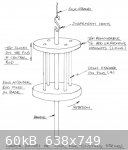
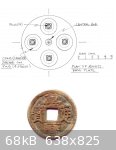
|
|
|
jdowning
Oud Junkie
    
Posts: 3485
Registered: 8-2-2006
Location: Ontario, Canada
Member Is Offline
Mood: No Mood
|
|
In order to determine the total weight of a 'Zhui' according to the number of 'threads' in a 'strand' to be twisted we need to know the weight of a
Chinese 'cash' coin at the time 'Taiyin Daquanji' was written.
The English term 'cash' refers to coinage that was legal tender in China from the second century B.C. until about the mid
20th C.
The coin is typically round with a square hole in the centre (see the previous posting) and cast from bronze (other metals and alloys were also
sometimes used but are not considered here).
As the coin had small monetary value they were issued in strings (like a necklace) with typically 1,000 coins to a string - hence the need for a hole
in the middle of the coin.
The coins were minted in vast quantities over a period of 2,000 years - literally millions or even billions of coins finding their way into
circulation.
Early Chinese coinage is a complex specialised field of study but there is a great deal of detailed information about the coins provided, on the
Internet, by the experts.
In reviewing the available data, surviving coins minted from A.D. 1055 (Liao Dynasty) until the 15th C (during the Ming Dynasty) were included - on
the assumption that earlier minted coins remained in circulation for several hundred years so might have still been available at the time 'Taiyin
Daquanji' was written.
The Ming Dynasty (beginning in A.D. 1368 ) saw the introduction of new standards in the minting of coins. In particular coin denominations of 1 cash,
2 cash, 3 cash, 5 cash and 10 cash were specified proportionally by weight - for example, a 3 cash coin should weigh 3 times more than a 1 cash coin,
a 10 cash coin 10 times more and so on. It was specified that 160 of the 1 cash denomination coins should be made from 1 jin (equivalent to 604.79
grams) of copper. As the coin value was based upon weight, the coins were called qian so that 1 qian (1 cash) weighed 3.78 grams. In practice -
because of dimensional tolerance variations inherent in the casting process and general lack of precise control over the minting of the coins - quite
wide weight and dimensional variations are to be found in the surviving coins from this time period.
The best approach, therefore, has been to determine an average value for coin weights and dimensions of the period.
The attached plot of the weight of 1 cash, cast bronze coins is derived from the measurements of 124 specimen coins. Coin diameters of this sample
range from 23.5 mm to 25.5 mm.
From this data, the average coin weight was calculated to be 3.7 grams with an average diameter of 24.5 mm. The average coin thickness was calculated
to be around 1 mm assuming an alloy density of 8 grams/c.c.
So, from this it might be concluded that - according to the 'Taiyin Daquanji' - the weight required to correctly load silk 'threads' during the
twisting process is about 15 grams per thread (i.e. the weight of 4 coins of 1 cash denomination) - not including the weight of the wooden frame of
the 'Zhui'.
How can we know that 1 cash coins were intended to be used rather than the higher denomination coins of 2, 3, 5 or 10 cash? Turning again to John
Thompson's translation - the original author of the text adds that one coin may take the place of three. If interpretation of the text is correct,
therefore, this might only mean that a 3 cash denomination coin may be substituted for 3 coins of 1 cash denomination. Therefore, the 'small coins'
used for the weights would usually be 1 cash
(1 qian) coins.
Turning to the translation of the 19th C text 'Yuguzhai Qinpu' for comparison, the weight specified for loading the strings while being twisted is
given as 4 ounces. Assuming the ounce to be a Chinese ounce (tael) which is equivalent to 37.8 grams the total loading would be 151 grams. However, as
the text does not relate this loading to any string size or 'thread' count the information can be of no use for this project.

|
|
|
jdowning
Oud Junkie
    
Posts: 3485
Registered: 8-2-2006
Location: Ontario, Canada
Member Is Offline
Mood: No Mood
|
|
A proper understanding of how a 'Zhui' was designed and used to make instrument strings has eluded me for a number of years as the translations of the
early texts are not clear.
I had visions of the string maker laboriously turning the device by hand and counting the several hundred if not thousand revolutions necessary to
make a string. Not an efficient method it would seem.
However, a key part of a'Zhui' may be the handle that I have assumed projects underneath the base plate - a superfluous feature it would seem as it
would be just as easy to turn the frame by hand.
Another important clue is given under the heading 'Method of Operation' in John Thompson's translation - "If you wrapped (zio: lit rub palms together)
(the 'thread' bundles) to the left, then you should combine the strands to the right. The tighter these are twisted together the better". This
describes the usual construction of a four 'strand' cord or string.
However, it is the reference to "rubbing palms together" that is interesting. If the handle of a 'Zhui' is rotated by rolling it between the palms of
each hand, it becomes in essence a geared friction drive. The attached images illustrate the process (using a pen to simulate a handle). A right
handed person gives the handle a rotation to the left (anti clockwise) the number of revolutions per stroke of the hands being dependent upon the
diameter of the handle. (I counted four rotations of the pen per stroke and six using a pencil of 7 mm diameter). Additional revolutions would follow
given this initial spin due to the weight of the 'Zhui' acting like a flywheel.
There is no mention of the number of turns required to make strings in the early texts only that the 'strands' should be twisted together as tightly
as possible. Using this method, however, it is likely that an experienced and skillful string maker might easily judge the degree of twist not only
from the appearance of a 'strand' and the increasing resistance to turning the 'Zhui' as twisting progressed but also by keeping each 'Zhui' exactly
in line with its neighbours as twisting progressed to completion.
This judgment would also be made easier by making long lengths of string at one time - the vertical movement of each 'Zhui' then being less sensitive
to the number of twists than it would be for shorter lengths.
We know from the texts that the early Chinese made their strings in long lengths. More on this to follow.

|
|
|
jdowning
Oud Junkie
    
Posts: 3485
Registered: 8-2-2006
Location: Ontario, Canada
Member Is Offline
Mood: No Mood
|
|
Both the 15th C 'Taiyin Daquanji' and the 19th C 'Yuguzhai Qinpu' describe the silk strings being twisted in long lengths one end of the string being
attached to a tall structure such as a tower and hung vertically with the 'Zhui' at the bottom end.
John Thompson gives the initial length of the 'thread bundles' as 94 ft (29 metres), however, he appears to have used modern Chinese linear
measurements in his translation with a Chinese 'zhang' taken to measure 141 inches (this might also be an error as a modern 'zhang' measures 131
inches).
During the Ming Dynasty a Chinese foot (chi) measured about 0.32 metre and a 'bu' (5 chi) measuring about 1.6 metres. On this basis, a zhang (10 chi)
would have been the equivalent of 3.2 metres (compared to 3.4 metres today - source Wikipedia).
Therefore, the initial length of the 'threads' for a Ming Dynasty silk string maker would have measured 10 chi X 8 equivalent to 24.8 metres (80 ft)
by today's standards. After being twisted into a string, the final length was 25% less or 10 chi X 6 equivalent to 19.2 metres (62 ft).
These corrected lengths now closely match those given in the 'Yuguzhai Qinpu' translation of 80 ft and 60 ft respectively.
The 60 ft length would then be cut into 10 - 6 ft lengths for use as instrument strings.
This string making process, being a vertical rather than horizontal, creates another puzzle. If the twisted string shrinks in length by 20 ft (6
metres), how does the string maker manage to reach the 'Zhui' as the twisting progresses? He might use a spiral staircase 20 ft high perhaps? Another
solution might be to design the upper anchor block so that it can be drawn downwards as twisting progresses - as shown in the attached schematic.
Nevertheless, the whole apparatus would have to take up space well over 100 ft (30 metres) high.
European string makers made their cords, ropes and strings etc. horizontally using geared 'twirls' mounted on a sled that slid along the ground as the
cord reduced in length and provided the required tension.
It will be interesting to test the Chinese method although the tallest building that I have on my property will only allow a finished string length of
about 15 ft (4.6 metres) to be made.
More on this at a later date.
The ancient Chinese zither (qin) strings were longer and of heavier gauge than required for an oud and were of four strand (but sometimes three
strand) cord construction. Interestingly, the 'Yuguzhai Qinpu' gives the size of the top three treble strings for a medium sized, seven string qin as
having 48 threads, 54 threads and 64 threads respectively.
Our project oud strings will have a thread count of 48 for the 'Mathna' and 64 threads for the 'Bam' strings - as specified by the 'Kanz al-Tuhaf'.
This is a good indication that these two strings should be made with either a three or four strand construction.
My guess is that the optimum construction of the oud strings might turn out to be:
'Hadd' - 2 cord (2X8 threads = 16)
'Zir' - 3 cord (3X8 threads, or 2X12 threads = 24)
'Mathna' - 4 cord (4X8 threads = 32)
'Mathlath' - 4 cord (4X12 threads = 48)
'Bam' - 4 cord (4X16 threads = 64)
However this is just guesswork at this point in time.

|
|
|
jdowning
Oud Junkie
    
Posts: 3485
Registered: 8-2-2006
Location: Ontario, Canada
Member Is Offline
Mood: No Mood
|
|
I seem to have omitted the second part of the twisting operation for the Chinese string making process.
Once each of the four 'thread' bundles have been fully twisted into 'strands', the four 'Zhui' are tied together as a group and then released to
revolve freely of their own accord. They will then rotate together - under the influence of gravity - in the opposite direction to the twist of the
strands (i.e. to the right or clock-wise) combining the strands into a stable string. In order for the completed string to be tightly twisted, the
'strands' must themselves first be twisted as tightly as possible.
This is explained in the 'Yuguzhai Qinpu' as " Revolve it (i.e. the 'Zhui' ) to the left and twist the strands extremely tight. Let it turn to the
right and come together becoming a string approximately 60 ft in length" and in the 'Taiyin Daquanji " as "If you twisted the 'thread' bundles to the
left, then you should combine the 'strands' to the right. The tighter these are twisted together the better. The original length of eight zhang
becomes a string about six zhang in length"
Included here for completeness, the centuries old European 'horizontal' method for making strings, cords and ropes is more complicated (although more
conveniently undertaken at ground level).
The attached images from the 18th C. 'L'Encyclopedie' by Denis Diderot (Vol. III, Planche 1, 'Corderie') illustrates the apparatus and procedure for
making small diameter two or three strand strings, cords or ropes. The engraving of a rope maker's workshop shows a two strand cord being combined (or
'laid') into a cord - the required tension being provided by a free hanging weight (with the cord passing over a fork) and the twist being controlled
using a two grooved 'top' (item c, 'toupin').
Tension is provided when combining a three strand cord (or 'merlin') by a workman holding a swivel hook (l'emerillon) that allows the strands to
freely rotate and combine together. (In this case, the 'top' has three grooves).
The 'thread' bundles are twisted into 'strands' simultaneously and equally using a geared machine driving four hooks or 'twirls'. The machine can
therefore be used to twist two, three or four strands simultaneously as required.
Enough already - lets try to make some strings!



|
|
|
jdowning
Oud Junkie
    
Posts: 3485
Registered: 8-2-2006
Location: Ontario, Canada
Member Is Offline
Mood: No Mood
|
|
My vertical rig for the string making trials (images previously posted 28 January) is a compromise taking advantage of the ancient Chinese method of
applying a constant tension but using a geared drive to twist the strings. The geared drive will enable an investigation of the optimum number of
turns for making each string.
First, a couple of tests were run to verify the functionality of the rig and to get a preliminary 'feel' for the best method. For this test ordinary
spun polyester sewing thread was used - itself a mini two strand twisted yarn - so not properly representative of the raw silk 'thread' that will be
used for the trials.
As the rig has only one geared drive, each silk 'thread' bundle will have to be individually twisted into a 'strand' then removed from the rig and
stored until the remainder of the 'strands' have been prepared. The separate 'strands' will then be attached to a common anchor point so that they can
be 'laid' - under direct gravitational loading - into the completed string.
The rig has been provided with a series of peg holes on one side so that the 'thread' bundles can be assembled. This is done by first winding the
'threads' around two wooden dowels spaced a suitable distance apart (e.g. 8 winds for a 16 thread strand). The loose ends are tied off at one end and
loops formed at each end by tying the threads together close to the dowels. This then enables the thread bundle to be removed from the rig and easily
handled without danger of the threads becoming tangled.
An 8 thread bundle, 1 metre in length, was then placed in the rig for twisting into a 'strand', one dowel being fitted into the double hook on the
geared drive and the other dowel into the sliding carriage. The weight box on the carriage was (arbitrarily) loaded to about
1 Kg weight to tension the thread bundle and the bundle then twisted 350 turns. The strand was then removed and stored under tension by fitting the
dowels into the peg holes at the side of the rig. A second strand was then prepared and the two strands fitted to a common anchor point. A 1 kg weight
was then hooked over the two dowels at the other end and the whole assembly was allowed to freely rotate under gravity to combine the strands together
into a string.
The attached images show the completed string - nowhere near the degree of twist required but a useful first step in the 'learning curve'.
A second test was performed with a six thread bundle,
1 metre in length. The 1 kg load caused the bundle to intially stretch by 3 cm. 700 turns were then applied to the bundle , this degree of twisting
causing a reduction in length of the strand from 100 cm to 83 cm. Still more turns required!
Next time around, the dowels will be replaced by metal 'S' hooks for the twisting process. The sliding carriage will also be scrapped and replaced by
(equal) individual weights for each strand in order to maintain a proper, balanced strand tension throughout.
So far so good. Lets try some silk 'threads' next.
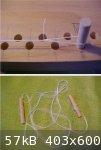
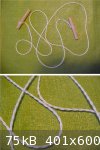
|
|
|
jdowning
Oud Junkie
    
Posts: 3485
Registered: 8-2-2006
Location: Ontario, Canada
Member Is Offline
Mood: No Mood
|
|
For the preliminary string making trials I shall be using a small sample of raw silk that I have to hand (not the sample material recently supplied by
'Treenway Silks' that has yet to be processed once the necessary skein winding apparatus has been completed).
As I am not sure about the thread size of the silk (it is too fine and soft be measured with a micrometer) a short test string was twisted from 16
threads and the diameter of the assembly measured using a micrometer and dial calipers as 'go/ no go' gauges (i.e. the gap on the measuring tool is
set so that it will just slip over the string without pressure being applied)
The diameter measured was 0.018 inch (0.46 mm) so this is a good indication that this silk thread will produce a 16 thread, simply twisted 'Hadd'
string of around 0.4 mm in diameter - about where we want to be.
The short test string was then destructively tested by applying tension with a spring balance. The string broke at around
3.5 Kg loading. However, the string would have failed at a higher load had the threads been bound together with gum as a uniform assembly, so this
test is a rough indication that a string of this size should be able to work as an instrument string with a tension of 3.5 to 4 Kg.
If my assumptions and calculations concerning the ancient Chinese string making practices are valid (and apply equally to 14 th C oud string making),
the thread bundles must be loaded with weights during the twisting into strands as follows:
8 thread bundle - 120 grams
12 thread bundle - 180 grams
16 thread bundle - 240 grams
These loadings apply to strings made from four strands (sometimes three) so may not be valid for smaller diameter oud strings that might have to be
made as simply twisted strands (for strength). Nevertheless it is a starting point for these trials. (Note that the loading for a 16 thread bundle is
only about 7% of the breaking load of the short test string - which seems to be rather low?))
To tension each thread bundle (8, 12 or 16 in number) at the required load, standard steel washers are to be used (a 3/8 washer weighing 6 grams)
placed on a wooden carrier (for each thread bundle).
Wire hooks have been quickly and easily formed from galvanised 14 gauge fencing wire using pliers and a wire bending tool (Lee Valley cat# 92W67.01 @
$8.50).
To prevent the load rotating during the twisting operation, the wooden weight carrier is square based and guided with an adjustable guide. The rig is
a bit 'rough and ready' but should be good enough to obtain the data required.
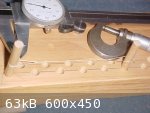
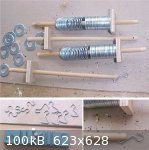
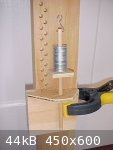
|
|
|
jdowning
Oud Junkie
    
Posts: 3485
Registered: 8-2-2006
Location: Ontario, Canada
Member Is Offline
Mood: No Mood
|
|
A sample of Gum Arabic has been made up to a very thick, viscous consistency so that addition of a 'little essence of Saffron' will dilute the gum to
a workable "paste of moderate consistency" - although at this point it is not known - in practical terms - how much 'a little essence of Saffron"
might be (or its concentration) or what is meant by "a paste of moderate consistency" in the Kanz al-Tuhaf instructions for silk string making.
The viscosity of the Gum Arabic sample is such that when the containing glass jar is turned on its side, it takes several seconds before the gum flows
under influence of gravity (room temperature 24 C - or 72 F, Relative Humidity 45%). This volume of Gum (10 cc) was then diluted with 0.5 cc of a
prepared sample of 'essence of Saffron' (0.25 gram in 10 cc of 40% ethanol in water solution). At this dilution the rate of viscous flow of the Gum
was judged to have about doubled.
The addition of the 'essence of Saffron' did not change the colour of the Gum significantly. As the 'Essence of Saffron' is added (according to the
Kanz al-Tuhaf) to 'stain' the strings this likely is an indication that the test batch of 'essence of Saffron' is not sufficiently concentrated for
the purpose. A more concentrated batch will, therefore, be made up for future tests (using 40% ethanol solution rather than methanol - for safety
considerations, methanol being a deadly poison).
The gum is applied to the completed strings "... rubbed on the strings with a piece of linen until it has penetrated into all the parts when the
string is dried"
The first preliminary trials with application of the Gum solution have been carried out on the two strand trial string previously made from spun
polyester thread - just to see what happens.
More to follow.
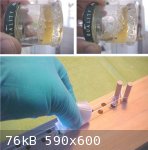
|
|
|
jdowning
Oud Junkie
    
Posts: 3485
Registered: 8-2-2006
Location: Ontario, Canada
Member Is Offline
Mood: No Mood
|
|
The two strand string made from spun polyester sewing thread, with its normal 'back twist' of the combined strands, is a stable string when not under
tension but which happens to have an 'open' low twist construction. To increase the degree of twist (necessary for an instrument string) the strands
would have to be twisted much tighter before being combined (laid).
However another possibility might be to start with low twist strands and then apply extra back twist to the string to increase the degree of twist in
the finished string. This results in an unstable string that will combine upon itself once the string tension is released. So, for this to work, the
extra back twist would need to be locked in place with gum before tension is released.
The string construction alternatives therefore are:
1) simply twisted - unstable
2) 2, 3 or 4 strand - stable
3) 2, 3 or four strand with additional backtwist - unstable
We do not know what form of construction applied to the 'Kanz al-Tuhaf' oud strings so must try all of the possible alternatives to find the optimum
solution.
Application of the gum arabic after a string has been twisted (yet still under tension) serves not only to bind the string into a uniform mass but
also to stabilise those strings with unstable configurations.
To put matters to the test, the polyester trial string was cut in half - one half left with the normal back twist and the other with additional back
twist applied. Both string sample were placed under tension - to draw the threads tightly together - and the Gum Arabic was rubbed into each
string.
The Gum took only a few minutes to dry at room temperature.
The attached before and after macro images show the result. (note that the spun polyester thread is hairy and not suitable for instrument string
making. Silk filament will not suffer from this problem).
The macro images show that the Glue contains many very small air bubbles (undesirable) - an indication that the Gum viscosity was too high and needs
to be further diluted for future trials.
The strings - after the Gum has dried are a little stiff after tension is released - so are first 'conditioned' by wrapping them around a pencil. This
gives the string the flexibility of a bootlace - exactly what is required.
Out of curiosity, each 'string' (35 cm long and 0.71 mm diameter) was brought up to a higher tension and plucked with a fingertip. To my surprise the
short thick strings sounded quite sonorous with a sustain of a few seconds.
An encouraging result to start with.
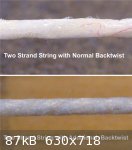
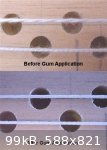
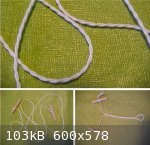
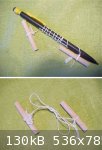
|
|
|
jdowning
Oud Junkie
    
Posts: 3485
Registered: 8-2-2006
Location: Ontario, Canada
Member Is Offline
Mood: No Mood
|
|
A new batch of 'Essence of Saffron' has been made up for the next set of trials with reeled silk thread.
The first batch was made from 0.25 grams of Saffron in 10 ml (cc) of 40% ethanol solution in water. This concentration failed to stain the Gum Arabic.
This may have been because the Saffron was too old and dried out having been stored in our kitchen for many years.
The new batch has been made from recently purchased Saffron, 1 gram being added to 10 ml of 40% ethanol in water solution. Most of the solution has
been absorbed by the herb and the golden yellow stain is sufficiently concentrated to colour the sides of the glass container. The liquid also smells
strongly of Saffron.
A further 5 ml of 40% ethanol has been added to the new batch so that there is a liquid level above the Saffron in the container. It will likely take
a while for all of the dye to be extracted. Further ethanol solution may have to be added later.
The first stage of the trial for making strings from reeled silk will be to prepare two 16 thread simply twisted 'Hadd' strings - one with low twist
the other with high twist - for comparison. As well four 8 thread strands will be be prepared two to be made into a two strand 'Hadd' string with
normal back twist, the other into a two strand string with additional back twist.
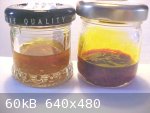
|
|
|
jdowning
Oud Junkie
    
Posts: 3485
Registered: 8-2-2006
Location: Ontario, Canada
Member Is Offline
Mood: No Mood
|
|
Two samples of 16 thread strand bundles have been prepared ready for twisting trials.
The silk thread used for these preliminary tests under magnification appears to be made from two reeled threads of raw silk loosely twisted together
(see attached image) - possibly originally a fine silk embroidery yarn? No matter, it will do for these preliminary trials although the ultimate
tensile strength of the completed oud strings will be somewhat lower than if reeled cocoon filament silk had been used.
The strand bundles were wound (8 windings) between two wooden dowels placed a metre apart on the string twisting rig. The ends of the bundles were
tied together at each end with a piece of cotton sewing thread and the loose ends of the silk threads knotted together around the dowel to complete
the bundle.
The first string bundle contains a small knot where the silk worker has repaired a break in the thread - normal practice for the industry. For future
string making, such discontinuities will not be included.
As previously discussed, we know from the description in the Kanz al-Tuhaf that the silk threads were de-gummed (the sericin gum dissolved) before
being made into strings by boiling the threads in water to which wood or vegetable ash has been added. This is a fairly critical procedure as soaking
silk in too strong a caustic solution for too long at too high a temperature can damage the silk.
For this test the de-gumming solution was made by adding a tablespoonful (15 ml) of wood ash to 1.5 litres of boiling water.
To avoid tangling of the thread bundles during de-greasing, the bundles were wound around a large coffee can. The can was then placed in the hot
de-greasing solution (78 C/175 F), and weighed down by adding 1.5 litres of hot water to the can and the silk thread bundles allowed to remain
immersed for 10 minutes. The can was then removed and the (hopefully!) de-gummed threads washed under fresh running water. The can and threads are now
left to dry thoroughly before being twisted into 'Hadd' strings.
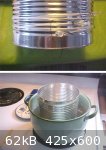
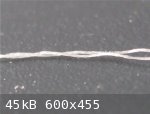
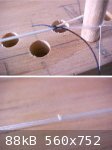
|
|
|
jdowning
Oud Junkie
    
Posts: 3485
Registered: 8-2-2006
Location: Ontario, Canada
Member Is Offline
Mood: No Mood
|
|
After drying on the coffee can overnight the two degummed thread bundles were removed for twisting into strings.However, the thread bundles were found
to be lightly stuck to the can and after being gently removed had the appearance of a flat, loosely bound silk tape.
Clearly the degumming operation had not completely removed the Sericin. Either the concentration of the caustic degumming solution was too weak or
immersion time was too short or solution temperature too low or a combination of these factors.
The degumming operation must, therefore, be repeated until all Sericin is removed and the silk threads can be twisted in a dry state.
The ancient Chinese string makers - as we have seen - did not attempt to remove the Sericin - but twisted the threads when wet with the Sericin in a
softened state using the Sericin to bind the silk threads into a uniform string.
The Kanz al-Tuhaf on the other hand states that after boiling the silk threads in the caustic solution of water and ash (i.e. degumming) they are then
dried - and then presumably twisted into strings in a dry condition (but that is not confirmed in the manuscript). The threads were then bound
together with Gum Arabic.
Efficient degumming of silk is a critical operation a technique well understood and practiced by the silk industry. Perhaps it might be easier in the
long term to purchase reeled silk already degummed from suppliers (if such a product is commercially available - which I doubt)?
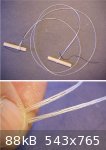
|
|
|
jdowning
Oud Junkie
    
Posts: 3485
Registered: 8-2-2006
Location: Ontario, Canada
Member Is Offline
Mood: No Mood
|
|
A second attempt was made today at degumming the thread bundles - this time following my own recommendations (!) following tests on wood ash
alkalinity previously posted.
The recommendation is 1 tablespoon (15 ml) of wood ash for every 500 ml of water. The raw silk is then simmered for 30 minutes in this solution
(simmer temperature is just below the boiling point of water - about 98 C). After simmering the silk is then rinsed thoroughly with clean water to
remove all traces of the degumming solution.
In an attempt to prevent tangling during degumming, each bundle was loosely tied with cotton thread to a wire ring. This, however, was only partially
successful as some tangling of the threads still occurred due to water movement during simmering. The thread bundles were carefully separated while
still wet but the tangled end loops may have to be re-tied before twisting into strings.
A better arrangement would be to wind the thread bundles fairly tightly onto a cylinder keeping each winding separated and with the end loops anchored
to pins.
The degumming operation using wood ash solution seems to have been successful, the silk now having a silvery sheen and the threads no longer stuck
together. With the sericin gum removed some slight 'hairiness' of the threads can now be seen in places due to separation of the fine cocoon reeled
filaments making up the threads.
Interestingly, ash (from the Banana plant) is used today in India to degum the cocoons of the wild Tussah moth.
So - with the thread bundles now degummed - on to the twisting operation.

|
|
|
| Pages:
1
2
3
4
..
13 |